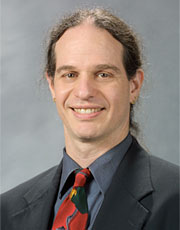Professor’s grant supports sickle cell-related research

Daniel B. Kim-Shapiro
Daniel B. Kim-Shapiro, associate professor of physics at Wake Forest University, has been awarded an Independent Scientist Career Development Award (K02) from the National Heart, Lung, and Blood Institute (NHLBI) of the National Institutes of Health (NIH) for his project “Nitrite and Nitric Oxide in Sickle Cell Blood.”
The award is a five-year, $518,400 grant that will allow Kim-Shapiro to continue his research into the uses of nitrite, a common salt found in the body and in foods such as hot dogs and lettuce, and nitric oxide, an important molecule made in the human body, as therapeutic agents for sickle cell and other vascular diseases.
The Independent Scientist Career Development Award is given to highly regarded scientists who have ongoing, independent, peer-reviewed research support and who need a period of protected research time in order to foster their research career development. The award is intended to foster the development of outstanding scientists and enable them to expand their potential to make significant contributions to their field of research.
Kim-Shapiro has been investigating sickle cell and other vascular diseases for nearly a decade. In 2002, he was awarded a five-year, $1.5 million grant from the NIH to study the effects of nitric oxide in sickle cell blood. His laboratory, in cooperation with colleagues from the NIH, the Medical College of Wisconsin (MCW), and the University of Alabama at Birmingham (UAB), has made important discoveries indicating that nitrite also has therapeutic potential in many vascular disorders.
In December 2003, the journal Nature Medicine published a paper co-authored by Kim-Shapiro and members of his lab that showed that, contrary to the widely held belief that nitrite is inactive under physiological conditions, nitrite itself causes blood vessels to open up.
Kim-Shapiro and his colleagues at the NIH, MCW and UAB hypothesize that nitrite serves as a storage pool for nitric oxide that is actually activated by its reaction with deoxygenated hemoglobin. Thus, when oxygen concentrations are low, nitrite reacts with hemoglobin to produce nitric oxide, open up the blood vessels and increase oxygen in the blood vessels and surrounding tissues.
Even if the physiological role for nitrite hypothesized by Kim-Shapiro and his colleagues proves to need major revision, there is great promise for use of nitrite as a therapeutic agent.
In November, Nature Medicine published another paper co-authored by Kim-Shapiro that suggests that nitrite may be effective in treating a condition affecting about one in 700 births where the babies suffer from problems in breathing due to a condition known as persistent pulmonary hypertension. The study indicates that nitrite may constitute a better and cheaper treatment than using inhaled nitric oxide, a common procedure performed today.
Kim-Shapiro plans to collaborate with physicians at the Wake Forest University School of Medicine and a group at the NIH that is studying the use of nitrite for the treatment of patients with sickle cell disease.



